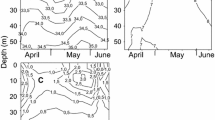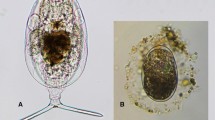Abstract
Collection and culture of the large lobate ctenophore Mnemiopsis mccradyi Mayer is described, including the requirements for successful development of larvae. Particular attention must be given to the collection of these delicate animals, the handling and provision of live microzooplankton of suitable size for the larvae, and the provision of food densities for the adults which neither stimulate “wasteful” feeding nor limit their growth. Although these ctenophores will ingest detritus and algal cells in high concentration, they lost weight at the same rate as starved individuals unless provided with living zooplankton. Under optimum conditions, specimens would lay eggs within 13 days of their own birth. By the 17th day they laid eggs daily, and had produced an average of 8,000 eggs within 23 days after birth. The maximum number of eggs laid by a single wild individual within 24 h after being brought into the laboratory was 10,000. Their high fecundity, rapid generation time, and ability to self-fertilize help to explain their sudden appearance in bloom proportions at periods of high food concentration in the environment, often referred to in the literature.
Similar content being viewed by others
Literature Cited
Baker, L.D.: Ecology of the ctenophore Mnemiopsis mccradyi Mayer, in Biscayne Bay, Florida. Rosenstiel School of Marine and Atmospheric Science, University of Miami, Tech. Rep. UMRSMAS-73016 (1973)
Bigelow, H.B.: Exploration of the coast water between Nova Scotia and Chesapeake Bay, July and August, 1913, by the U.S. Fisheries Schooner, Grampus. Oceanography and Plankton. Bull. Mus. comp. Zool. Harv. 59, 149–359 (1915)
— and M. Sears: Studies of the waters of the continental shelf, Cape Cod to Chesapeake Bay. III. A volumetric study of the zooplankton. Men. Mus. comp. Zool. Harv. 54, 183–378 (1939)
Cronin, L.E., J.C. Daiber and E.M. Hulburt: Quantitative seasonal aspects of zooplankton in the Delaware River Estuary. Chesapeake Sci. 3, 63–93 (1962)
Fraser, J.H.: The role of ctenophores and salps in zooplankton production and standing crop. Rapp, P.-v. Réun. Cons. perm. int. Explor. mer 153, 121–123 (1962)
Greve, W.: Cultivation experiments on North Sea ctenophores. Helgoländer wiss. Meeresunters. 20, 304–317 (1970)
Hirota, J.: Laboratory culture and metabolism of the planktonic ctenophore, Pleurobrachia bachei A. Agassiz. In: Biological oceanography of the Northern North Pacific Ocean. Motoda Commemorative Volume, pp 465–484. Ed. by A.Y. Takenouti. Tokyo, Japan: Idemitsu Shoten 1972
Hirota, J.: Quantitative natural history of Pleurobrachia bachei A. Agassiz in La Jolla bight. Ph.D. Thesis, Scripps Institution of Oceanography, University of California 1973
Hopkins, T.L.: The plankton of the St. Andrew Bay System, Florida. Publs Inst. mar. Sci. Univ. Tex. 11, 12–64 (1966)
Miller, R.J.: Distribution and energetics of an estuarine population of the ctenophore, Mnemiopsis leidyi. Doctoral Dissertation, 78 pp. Department of Zoology, North Carolina State University, Raleigh, North Carolina 1970
Nelson, T.C.: On the occurrence and food habits of ctenophores in New Jersey inland coastal waters. Biol. Bull. mar. biol. Lab., Woods Hole 48, 92–111 (1925)
Paffenhöfer, G.A.: Cultivation of Calanus helgolandicus under controlled conditions. Helgoländer wiss: Meeresunters. 20, 346–359 (1970)
Ponomareva, L.A.: Reproduction of Euphausiidae of the Sea of Japan and development of their early larval stages. Zool. Zh. 34, 85–97 (1959)
Reeve, M.R.: The biology of Chaetognatha. I. Quantitative aspects of growth and egg production in Sagitta hispida. In: Marine food chains, pp 168–189. Ed. by J.H. Steele. Edinburgh: Oliver & Boyd 1970
Reeve, M.R. and L.D. Baker: Production of two planktonic carnivores (chaetognath and ctenophore) in South Florida inshore waters. Fish. Bull. U.S. (in press)
— and M.A. Walter: Conditions of culture, food size selection and the effects of temperature and salinity on growth rate and generation time in Sagitta hispida Conant. J. exp. mar. Biol. Ecol. 9, 191–200 (1972)
Rowe, M.D.: Some aspects of the feeding behavior of the ctenophore Pleurobrachia pileus, 62 pp. Master's thesis, University of Hawaii 1971
Author information
Authors and Affiliations
Additional information
Communicated by J. Bunt, Miami
Contribution from the Rosenstiel School of Marine and Atmospheric Science, University of Miami, Miami, Florida 33149.
Rights and permissions
About this article
Cite this article
Baker, L.D., Reeve, M.R. Laboratory culture of the lobate ctenophore Mnemiopsis mccradyi with notes on feeding and fecundity. Mar. Biol. 26, 57–62 (1974). https://doi.org/10.1007/BF00389086
Accepted:
Published:
Issue Date:
DOI: https://doi.org/10.1007/BF00389086




